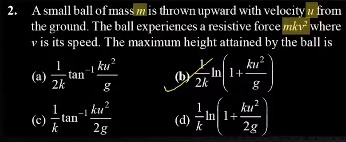Question
Question: A small ball of mass $m$ is thrown upward with velocity $u$ from the ground. The ball experiences a ...
A small ball of mass m is thrown upward with velocity u from the ground. The ball experiences a resistive force mkv2 where v is its speed. The maximum height attained by the ball is

A
2k1tan−1gku2
B
2k1ln(1+gku2)
C
k1tan−12gku2
D
k1ln(1+2gku2)
Answer
2k1ln(1+gku2)
Explanation
Solution
The net force acting on the ball when moving upward is
F=−mg−mkv2.Using vdxdv=dtdv, we have:
vdxdv=−g−kv2.Rearrange to separate the variables:
g+kv2vdv=−dx.For maximum height H, integrate from initial speed u (at x=0) to velocity 0 (at x=H):
H=∫0Hdx=∫u0g+kv2−vdv.Changing the limits we get:
H=∫0ug+kv2vdv.Now, substitute w=g+kv2 so that dw=2kvdv which implies vdv=2kdw. The limits change as follows:
- When v=0, w=g.
- When v=u, w=g+ku2.
Thus,
H=2k1∫gg+ku2wdw=2k1[lnw]gg+ku2=2k1ln(gg+ku2).This simplifies to:
H=2k1ln(1+gku2).By applying the chain rule vdxdv=−g−kv2 and integrating with the substitution w=g+kv2, the maximum height is found to be 2k1ln(1+gku2).
